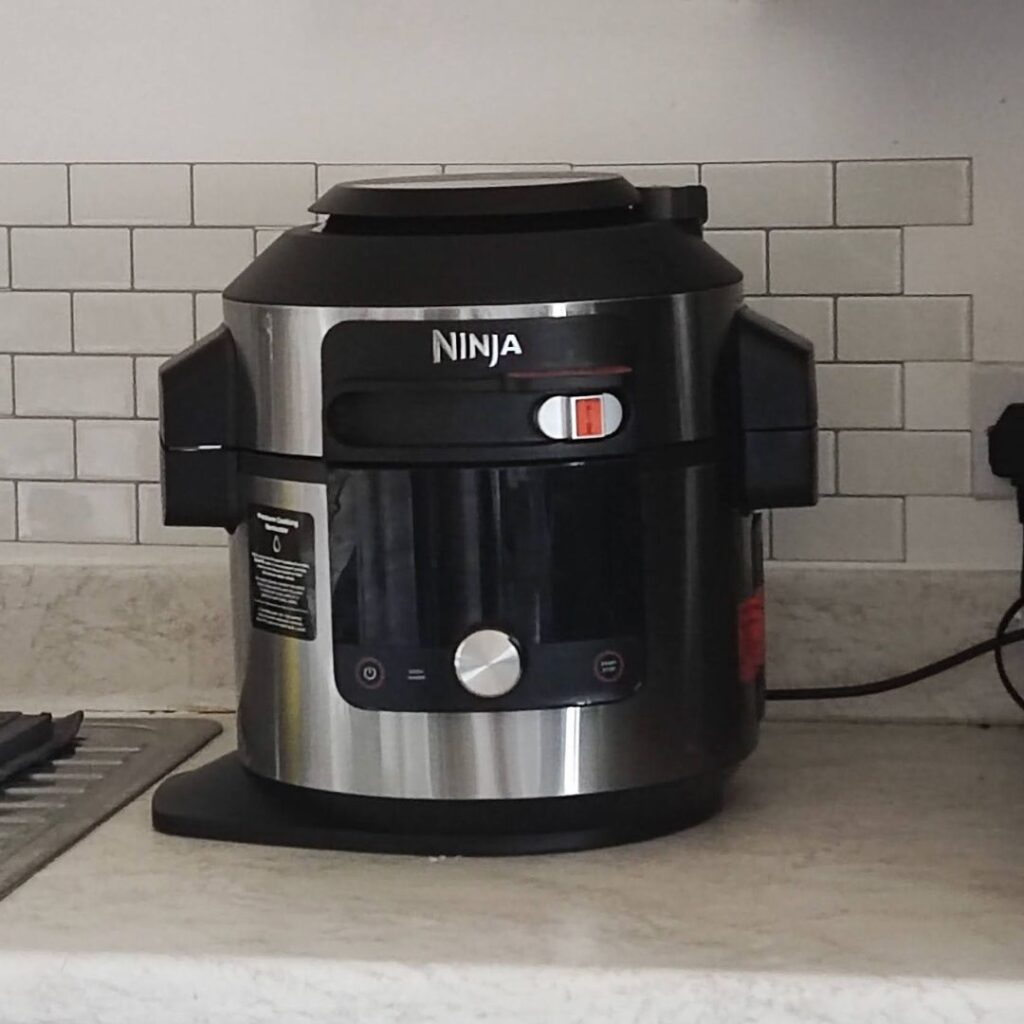Air frying has become increasingly popular in recent years, as more and more people look for healthier alternatives to traditional deep-fried foods. With its promise of using less oil while still providing that delicious, crispy texture you crave, it’s no wonder you’re curious and sometimes ask how healthy is air frying or about the health benefits it might offer.

Compared to deep-frying, air frying significantly reduces overall calorie intake, which can be beneficial for your health goals. By using hot air to circulate and cook the food, you can achieve a similar result without the need for excessive oil.
Consequently, you may consume fewer unhealthy fats and lower your exposure to potentially harmful inflammatory compounds found in some oil types. This process provides you with a healthier cooking method while still allowing you to enjoy your favorite fried foods.
In comparison to oven cooking, the air fryer might not offer a significant advantage, but its ability to cook food quickly and efficiently makes it a convenient option for everyday use. It’s essential to understand that while air frying may be a better alternative to deep-frying, maintaining a balanced diet and making healthy food choices always remain crucial for your overall well-being.

How Healthy is Air Frying
A quick guide to understanding how the air fryer works.
Hot Air Technology
Air frying is a cooking method that uses hot air to cook your food. This innovative technology circulates hot air around the food, allowing it to cook evenly and achieve a crispy texture similar to deep frying. The main advantage of using an air fryer is that it requires little to no oil, resulting in healthier dishes with fewer calories.

Appliance Components
An air fryer consists of a few essential components, such as a heating element, a fan, and a basket for holding the food. The heating element warms up the air inside the appliance, while the fan circulates the hot air around the food in the basket. The design allows the food to cook quickly and uniformly, achieving a desirable crispy texture.
Comparing air fryers to Deep Frying
When comparing air frying to deep frying, it’s important to consider several factors:
- Oil consumption: Air frying significantly reduces oil consumption, as it requires little to no oil. In contrast, deep frying submerges your food in oil, leading to higher calorie and fat content.
- Calorie intake: On average, using an air fryer can reduce calorie intake by 70 – 80% compared to traditional deep frying.
- Cooking time: Air fryers tend to cook food faster than deep frying or even baking in an oven. Just make sure not to overcrowd the basket to ensure even cooking.
- Flavor: While air frying doesn’t precisely replicate the taste of deep frying, it still produces a delicious, crispy texture that many people enjoy.
As you can see, air frying offers several benefits compared to traditional deep frying, such as reduced oil usage, lower calorie intake, and faster cooking times. With the proper use of an air fryer, you can achieve delicious and healthier meals for you and your family.

Health Aspects of Air Frying
Fat and Calorie Reduction
One of the main benefits of air frying is that it significantly reduces overall calorie intake by cutting down on fat. In fact, air frying can help you reduce your calorie intake by 70% on average compared to deep-frying. This means that you’ll be consuming fewer calories and less fat in your meals, which can ultimately contribute to a healthier diet.
Since owning 2 different air fryers, the amount of oil I have purchased has drastically reduced! I do not need to buy oil as frequently as I would before owning an air fryer.
Nutrient Retention
While air frying can help retain nutrients in certain foods, it may also affect some nutrient levels, particularly in fish. For instance, air frying fish may lower the amount of polyunsaturated fatty acids (such as omega-3 fats) and potentially increase the number of inflammatory compounds. However, it’s important to note that any cooking method will change a food’s composition to some degree.
To counterbalance the potential nutrient loss in air frying, you can:
- Add antioxidant-rich spices and herbs to your recipes
- Consume a variety of omega-3-rich foods to compensate for any loss
Reducing the Risk of Diseases
Air frying can play a role in reducing your risk of certain health problems as it typically involves using less oil than traditional frying methods. By consuming less saturated fat and cholesterol, you can lower your risk of heart disease and other health concerns.
However, it’s essential to maintain a balanced diet and not solely rely on air frying as a solution to all health risks. Incorporating a variety of cooking methods, consuming nutrient-rich foods, and practicing moderation is key to maintaining a healthy lifestyle.
Effects of Air Fryers on Food Quality
Crispiness and Texture
Air frying offers a healthier alternative to traditional frying, and it can improve the quality of various foods. When you use an air fryer, your favorite fried foods like french fries and chicken can achieve a crispy texture with less oil. This can lead to a significant reduction in calorie intake, often by 70 to 80%.
The hot air circulation in an air fryer works to create a crunchy exterior while keeping the inside moist. This is especially beneficial for recipes that require a crispy texture, such as fish and roast meat. However, it is worth noting that air-frying fish may lead to a slight reduction in the omega-3 content, which can be compensated by consuming more omega-3-rich foods.
Color and Flavor
Air frying not only affects the crispiness and texture of your food but also its color and flavor. Without the need for excessive oil, your fried food can maintain a more vibrant color, being less greasy and more appealing to the eye.
In terms of flavor, air frying can enhance the natural taste of your ingredients. Meats such as chicken breast will taste more delicious and less oily, while still retaining their moisture. The same is true for vegetables, as air frying can intensify their natural flavors.

When you choose to air fry your meals, you can be confident that you’re enjoying a healthier option with improved crispiness, texture, color, and flavor. Just keep in mind that air frying might not be the perfect choice for all recipes, and some dishes may require adjustments to achieve the desired result.
Choosing Healthier Cooking Techniques
When considering how healthy is air frying, the cooking method is of great importance.
Oil Selection
When it comes to air frying, selecting the right oil is crucial for both taste and health. Opt for oils with a high smoke point, such as avocado oil, grapeseed oil, or refined olive oil, to avoid harmful compounds that can form when oils break down. These oils also offer a balanced number of healthy fats, which is important for your overall well-being.
Food Preparation
Before you start air frying, pay attention to how you prepare your food. To minimize the fat content, trim any visible fat from meats like chicken or steak. Opt for leaner cuts when possible. When it comes to vegetables, try to keep them relatively uniform in size to ensure even cooking. Season your food wisely and consider using herbs and spices instead of salt. Additionally, avoid using excessive amounts of high-calorie sauces and dressings.
Alternative Cooking Methods
While air frying is a healthier alternative to deep-fried food, several other cooking techniques offer additional benefits:
- Baking: A practical alternative to air frying, baking uses dry heat in a conventional oven, allowing food to cook evenly without the need for added fat. Perfect for chicken and potatoes, baking can prevent excess calorie intake.
- Grilling: Grilling enhances the natural flavors of foods like chicken and vegetables while reducing fat content. The high heat creates a delicious charred exterior while keeping the inside moist and tender.
- Steaming or Boiling: These methods keep vegetables’ carbohydrates, minerals, and fiber intact since no oil is needed. Steaming and boiling can also help you consume fewer calories while enjoying the full nutritional benefits of your chosen foods.
By consciously selecting your oil, preparing food properly, and exploring alternative cooking techniques, you can reap the numerous benefits that come with healthier cooking while still enjoying delicious dishes.
Nutritional Factors to Consider
When discussing the health benefits of air frying, it’s important to consider various nutritional aspects that come into play. In this section, we will be evaluating the formation of acrylamide, the impact on omega-3 fats and oxidation, and how air frying can help control calorie intake.
Controlling Calorie Intake
A significant advantage of air frying over traditional frying methods is the ability to control your calorie intake. As you use less oil in air frying, the overall calorie and fat content of the food is considerably reduced, which can be beneficial for weight management and overall health.
Examples of Air Fryer Recipes
You can literally cook or prepare almost all foods you will make in an oven in an air fryer! These can be snacks/appetizers, main dishes, or desserts.
Potential Drawbacks and Limitations
Some limitations of air fryers include – having limited food capacity, being expensive, and taking up space. I have covered this in-depth in this post
FAQ on How Healthy Air Frying is
Air frying vs traditional frying health?
Air frying can be a healthier alternative to traditional frying as it uses little to no oil, resulting in less fat and calories in your cooked foods. Food cooked in an air fryer tends to have up to 80% less fat compared to deep-fried food.
Air fryers and cancer risk?
There’s currently no strong evidence directly linking air frying to an increased risk of cancer. However, studies have shown that consuming high amounts of acrylamide, a chemical formed in some starchy foods during high-temperature cooking like frying, may increase cancer risk. Air frying can produce lower levels of acrylamide than traditional frying, potentially reducing the associated risk.
Air fryer benefits for weight loss?
Using an air fryer can support weight loss goals by reducing the amount of fat and calories in your meals, as it uses less oil compared to deep frying. However, weight loss ultimately depends on your overall diet and physical activity.
Are air-fried foods nutritious?
The nutritional value of air-fried foods depends on the ingredients used. While air frying maintains the nutritional content of your ingredients better than deep frying, it is still important to maintain a balanced diet and avoid overconsumption of processed or unhealthy foods, even if they are air-fried.
Air frying pros and cons?
Pros of air frying include using less oil, reducing fat and calorie content, and potentially lower acrylamide levels. It also offers a quicker and less messy cooking process. Cons may include reduced crispiness compared to deep frying, the expense of buying an air fryer, and limited cooking capacity since air fryers are typically smaller in size.
Do air fryers emit harmful chemicals?
Some air fryers may release small amounts of harmful compounds such as perfluorooctanoic acid (PFOA) or polycyclic aromatic hydrocarbons (PAHs). However, these emissions tend to be minimal when compared to other cooking methods like grilling or frying. To further reduce your exposure to harmful compounds from air fryers, you can choose an air fryer that uses ceramic or stainless steel coated baskets rather than non-stick coatings containing PFOA.
So, next time you are having a conversation on How Healthy Air Frying is, I hope these points will come in handy.






